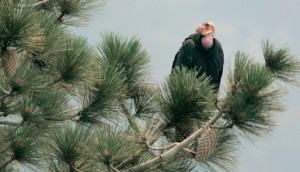ForestWatch defends old-growth trees where endangered condors rest

A condor perched in the Los Padres National Forest.
© AP/Marcio Jose Sanchez
In October, ForestWatch alerted the U.S. Forest Service that a tree-cutting project on Mt. Abel in the Ventura County backcountry would harm California condors. The endangered birds frequently use the trees for roosting and resting during long flights across the landscape, and removing the trees would violate federal laws that protect condor habitat.
The tree cutting is part of the Pine Mountain Club Project, a 1,865-acre vegetation clearing project in the Los Padres National Forest. The project – approved in 2008 – calls for the construction of a large fuel break on Cerro Noroeste (“northwest mountain,” also known as Mt. Abel) measuring more than 500 feet wide and nearly 1.5 miles long, plus an additional 495 acres of forest thinning on the mountain top. The fuelbreak would cut through the middle of an active condor roosting area, where condors have perched on large trees and snags for centuries due to the unique environmental conditions of the area.
California condors rely on roost sites throughout their range for resting after long-distance flights across the landscape, and for protection during storms and high winds. Traditional roosting sites are often located near important feeding and breeding areas. Condors often return to the same roost site year after year, and many traditional roost sites – including Cerro Noroeste – have likely been used for centuries due to their location, microclimates, and tree characteristics. California condors often spend the majority of their time perched at a roost, preening and grooming their feathers. Roosts may also serve an important social function, as condors usually roost in groups.
Due to the importance of roosts for condor survival, biologists generally recommend a half-mile buffer around condor roosting trees to protect them from noise and disturbance. The project did not incorporate this buffer, and ForestWatch sent the Forest Service a detailed notice in October 2012 outlining how tree cutting in the area would harm roosting condors and destroy the integrity of the roosting site. According to the ForestWatch notice, “The project entails removal of trees in and around traditional roosting and perching sites that are critical for the survival of endangered California condors. The Forest Service has failed to use the best available science in considering the impacts to these roost and perch sites and therefore has failed to ensure against jeopardizing the continued existence of the condor in violation of the ESA.”
This is not the first time that ForestWatch has expressed concerns about this project. In 2008, ForestWatch appealed the project, challenging the Forest Service’s conclusion that the tree clearing “would have no effect on the California condor.” The Forest Service denied our appeal, and shortly thereafter, ForestWatch notified the agency that tree removal in condor roosting areas would violate the Endangered Species Act.
In the years following, the Forest Service attempted to make changes to the project, but the changes fell short of what’s needed to adequately protect the roosting sites. The changes were made behind closed doors without any public review or input, and would still result in possible disturbance to roosting condors. The Forest Service also rejected our April 2012 request to revise the Environmental Assessment and allow the public to comment on the changes.
“Because the Forest Service recently denied our request to prepare a revised or supplemental EA for the project in light of this new condor information, we are filing this notice to summarize our concerns and to ensure that Project impacts to condors are minimized consistent with the best available science as required under the ESA,” said ForestWatch in the notice.

A condor roosts in the Sespe Wilderness. © Mike Klinger
Condor roosting behavior is not well understood, but condor biologists have known since the 1940s that condor roosts are susceptible to human disturbance, and that Cerro Noroeste is a prime condor roosting area. In fact, noted condor biologist Carl Koford states in his 1953 book The California Condor, “One man, by disturbing the birds at critical places late in the day, can prevent roosting over an area of several square miles.”
ForestWatch did not challenge any portion of the project adjacent to the Pine Mountain Club community. Work in those portions of the project began in 2011. The condor roosting areas are located more than two miles from the community.
We will continue to monitor this and other projects in the Los Padres National Forest to ensure that endangered condors have safe places to rest during their long flights across the landscape.







Comments are closed.